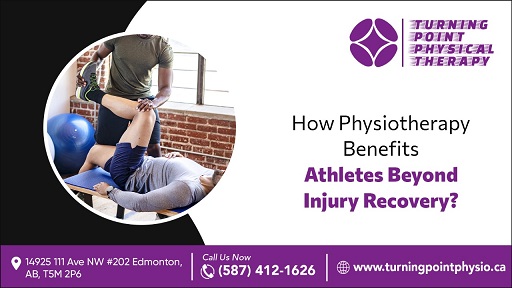Athletes quickly seek physio care when dealing with sprains, strains, or tears, but the benefits extend beyond simply getting back on the field or court. Physiotherapy in Edmonton offers athletes a solid foundation for an excellent athletic career. For athletes looking to reach their peak, understanding these benefits can be transformative. Edmonton Physiotherapy provides personalized treatment plans to help you recover, reduce pain, and get back to doing what you love.
1. Optimizing Athletic Performance with Functional Strength Training
Functional strength training, a cornerstone of physiotherapy, is designed to replicate athletes’ movements during their sport, building strength in a targeted way. Unlike traditional weightlifting, which often focuses on isolated muscle groups, physiotherapy in Edmonton emphasizes stability, coordination, and control in complex movement patterns.
How It’s Done: A physiotherapist assesses the athlete’s movement mechanics and designs a series of exercises that target weak points in their performance. Exercises may include single-leg squats for stability, kettlebell swings for explosive power, or multi-planar lunges for agility. To perform, Stand with feet hip-width apart for kettlebell swings, holding a kettlebell with both hands. Hinge at the hips, allowing the kettlebell to swing between the legs with a slight knee bend. Drive the hips forward explosively to swing the kettlebell to shoulder height, keeping the arms straight. Let it swing back down as the hips hinge again, controlling the movement with the core. Repeat for 10-15 swings.
2. Injury Prevention Through Biomechanical Analysis
Physiotherapy for athletes involves focusing on movement patterns and identifying risks before they evolve into injuries.
How It’s Done: The analysis often involves video feedback, gait analysis, hands-on flexibility and joint range of motion assessment. Physiotherapists use video feedback, gait analysis, and flexibility tests to assess athletes’ movement, identifying imbalances or limitations. Based on these findings, they prescribe corrective exercises or stretches to enhance muscle balance and joint protection. For instance, a Dynamic Hip Flexor Stretch can improve hip mobility by starting in a lunge, shifting weight forward until a stretch is felt in the hip, holding for 15-20 seconds, and then switching legs.
This proactive approach reduces the risk of common sports injuries, like ACL tears in soccer players or rotator cuff injuries in baseball players, by ensuring that athletes maintain proper movement form even during high-intensity activities.
3. Enhancing Flexibility and Mobility for Improved Range of Motion
Flexibility and mobility are critical for all athletes, particularly those involved in sports that demand a wide range of motion, like gymnastics, swimming, or martial arts.
How It’s Done: A physiotherapist guides athletes through targeted movements like hip openers, thoracic spine rotations, and shoulder flexion drills, often incorporating foam rolling and manual therapy to release muscle tension and improve soft tissue flexibility. To perform thoracic spine rotation, try to start at a tabletop position under the shoulders and knees under the hips. Place one hand behind the head, elbow out, and rotate the upper body, lifting the elbow toward the ceiling while opening the chest. Return to the starting position, repeat 8-10 times, then switch sides.
This exercise enhances upper back mobility and rotation, improving the range of motion for athletic movements.
4. Mental Conditioning and Focus for Enhanced Game Resilience
Physiotherapy doesn’t only address the body; it also aids in the mental resilience and focus athletes need to excel. Physiotherapists work with athletes to manage physical stress, which supports mental clarity and calm under pressure, ultimately benefiting performance.
How It’s Done: A physiotherapist may introduce mindfulness practices, controlled breathing techniques, and relaxation exercises, encouraging athletes to apply these methods in high-stress situations. To perform Deep Belly Breathing, try to sit or lie comfortably and place the patient’s hand on the abdomen. Inhale through the nose for a count of four, letting your belly rise. Hold the breath for four counts, then exhale slowly through the mouth for six counts, allowing your belly to fall. Repeat 5-10 minutes to calm the body and mind, enhancing focus and relaxation.
By integrating mental conditioning, athletes can better manage nerves, maintain composure, and sustain focus during critical sports moments. This mental resilience often translates into enhanced performance, especially during high-stakes competitions.
5. Recovery Optimization for Faster and More Effective Regeneration
Adequate recovery is essential for athletes to perform consistently. Physiotherapy offers many recovery strategies beyond typical rest days, helping athletes bounce back faster and reduce the risk of overtraining.
How It’s Done: Physiotherapists may use techniques such as active recovery exercises, hydrotherapy, massage therapy, and electrotherapy. Cryotherapy and compression garments may also be recommended to promote circulation and muscle relaxation. To perform Active Recovery Exercise, engage in light aerobic activity like brisk walking, cycling, or swimming moderately for 10-20 minutes. Keep the intensity low to promote blood flow and muscle relaxation. Finish with gentle stretching or foam rolling to enhance recovery and reduce soreness.
These methods facilitate quicker muscle repair, help manage delayed onset muscle soreness (DOMS), and minimize muscle fatigue. Athletes can return to training or competition feeling refreshed and rejuvenated, ultimately contributing to a sustainable athletic career.
Ready to Elevate Your Athletic Potential? Here’s How to Start
At Turning Point Physiotherapy Clinic, athletes receive the customized, expert care they need to reach their peak. From preventing injuries to optimizing movement mechanics, our team specializes in maximizing your performance while prioritizing safety and longevity through physiotherapy in Edmonton. Take the next step in your athletic journey with a team that understands the nuances of high-level performance—Are you looking for a physiotherapist near me? Contact Turning Point Physiotherapy in Edmonton today for expert care to help you recover, improve mobility, and reach your fitness goals—let’s build resilience, prevent injuries, and ensure a longer, more successful career.

